American Sabbatical 048: 11/7/96
Las Vegas
7come11...Vegas.
| An endless stream of airliners was angling down on Las Vegas as we flew into town on the jamfast
freeway. This IS the crossroads of America, folks, with people
from everywhere, in all shades and dialects, all bent on having
a ball. Fun City. The Get Lucky Theme Park. And whatever your
kink, you can get it untied in Vegas. |
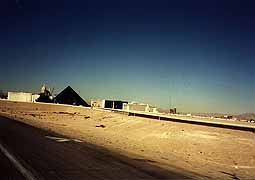
Desert Mirage
|
Interstate 15 runs northsouth through the city, one block west
of The Strip, so you parallel the casinos coming in, and the backsides
of the ultimate stageset wiggle at you in the overheated air.
We were delighted by the big blackglass pyramid at Luxor, with
its guardian sphinx and Cleopatra’s Needle, but we were startled
into hoots of joy by the new New York, New York, Casino, now in
the final stages of construction. It replicates all the signature
sites in NYC: Empire State, Chrysler Building, Statue of Lib.,
Brooklyn Bridge, City Hall, and a host of others, all in one conglomerate
pile decked out in desert gaudy. And it works. You realize how
a few details define a place, and have to admire set designers
who can recreate an entire city in one structure.
We swung off the throughway and entered the shining hustle and
jostle. Cruised the length of The Strip, gaping appreciatively.
Immense scrolling light screens promoting casino shows: The Tyson-Holyfield
fight, West Side Story, Tom Jones, Englebert Humperdink, David
Copperfield, Judy Collins, in lurid colors. Mega-billboards shouting
“The Loosest Slots on the Loosest Corner in town”, “Completely
Naked: Girlsgirlsgirls”,”Outlaw Women”, “Country Fever.” Cabs,
busses, faux-trollies covered in ads: “Smoky Robinson at Desert
Inn”, “Mystere at Treasure Island”, “Starlight Express at the
Las Vegas Hilton.” Flashing signs everywhere: “Breakfast 2AM-Noon
$2.50”, “Uproarious Comedy”, “Master of Illusions.” And the casinos
themselves. The gigantic lion at MGM Grand (you enter through
the mouth), a six-story Coca-Cola bottle in green glass, a boiling
cauldron 60 feet high with crackling gas flames and fountainous
overflow, a fullsized pirate ship sailing in the lagoon at Treasure
Island, the pylon tower with its revolving top at the Stratosphere.
And the soaring hotels, opening out into triple-winged Ys, in
hot colors and iridescent glass: blue glass, green glass, golden
glass, purple glass. And the whole city is perpetually under reconstruction,
so the big giraffe cranes and skeletal promises climb the sky.
Three humongus hotels in-the-building, casinos tearing down and
piling up, and the big signs rising. All woven together with throngs
of visitors and the accordion glitter of automobiles.
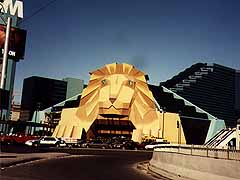
MGM
|
We scoped out the Super8 Casino, and it was good. While Peggy
was checking in I was glad-eyed twice in the lot. The women are
NOT shy in this town. And we called Bob and Frankie. They would
come by and take us to dinner and give us the local’s tour. Food
and lodging are a bargain in Las Vegas, at least in the casinos,
and every business is a casino. Smokes and slots. Pharmacy and
Keno. Get Lucky at breakfast. |
Our tour guides took us to the Rico, which they described as the
local’s casino, where the slots pay 95% and the food is abundant
and cheap. It didn’t take us long to realize that our old friends
from Bowdoinham were thorough Las Vegans. We played Keno as we
ate. Frankie won $20. We lost $10. Then we moved onto the main
floor. Ah the casino ambiance. Bright lights, shining eyes, mirrored
walls, resplendent costumes, glittering surfaces, eager hands,
the whir and clatter of the slots, quarters gushing into plastic
cups, electronic pulsing in the air, sexy waitresses in bunnysuits
strutting their alls on highheel, the rattle of ice in glasses,
the smug incense of tobacco, the whoops and groans, spinning wheels,
tumbling dice, sliding cards, rolling slots, flashing, bleeping,
clanging. The plush rugs and marble and mahogany, the sharp glances
from staff, the intense nonchalance of pickup artists, the tunnelvision
of the slots ladies, the glazed abandon and tangible eagerness
around the tables, and the extraordinary diversity of clientele.
They are truly democratic in Vegas. They’ll take anybody’s money.
They sure took ours. Our guides’ idea of a tour was an evening
with Lady Luck. I dutifully pushed bills into slots without expecting
to win, and didn’t score once. I’d rather save my luck for the
road, anyhow. But Peggy won just enough to keep her poking her
finger at the screen and feeding the machine until it had cleaned
her out. Meanwhile Bob and Frankie were in stride working the
options, trying to explain the angles and techniques of the life.
They were obviously a bit disgusted with us. “You’ve got to gamble
a chunk of change to win,” they counseled us. “Come in with a
couple of hundred you are willing to lose, and you get to play.”
Good advice, I’m sure. But we didn’t have the ante. They were
pushing $20 bills into the slots and, sure enough, they got enough
trys to stay in the win column. Frankie made $50, Bob broke even.
We got the feeling they spend a lot of time courting the lady.
Frankie didn’t wear one of those habitue’s glove, though, at least
not in company.
| Then they took us driving up and down the town. Bob said it’s
getting to be a rough town, with Hispanic gangs moving over from
LA. The mob used to keep the streets safe, but now we have good
government. The building boom is nonstop, and doesn’t pause for
market ticks or exchange rates. 5000 new folks come to town every
month looking for the silver lining, not counting the tourist/gamblers.
There are all kinds of scams and ripoffs in the construction game,
they said. Bob and Frankie had jumped through all the hoops to
get licensed as contractors, then spent their profits suing suppliers,
buyers, and other con artists. Now Bob is an employee of a big
contractor who works for the casinos. |
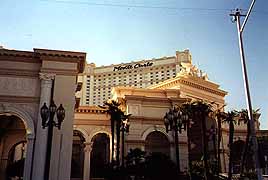
Monte Carlo
|
He took us to his current job. Bob is site manager constructing
the largest free-standing illuminated sign in the world, for the
Las Vegas Hilton. 268 feet tall. And he loves it. All he has to
worry about is getting the job done, and the job is a gas. Hi-tech
methods and materials, sophisticated engineering, hotshot highwire
crews, and someone else worries about the bankers. What more could
a builder want? In his site trailer there was half a million dollars
worth of epoxy. The base rods for the structure are epoxied into
holes drilled down into the compressed seabed that underlies Vegas.
This baby has to withstand winds over 100mph (which its predecessor
didn’t) and the steelwork is an intricate web which will fan out
into a glittering fountain of lights. Bob says there are more
lights on in Vegas than in all of New York City.. the other one.
This is the leading edge of modern architecture, No? Robert Venturi,
in his book “Learning From Las Vegas”, initiated the post-modern
era, by extolling the virtues of the Strip’s expressive architecture.
Or should I say excessive? He defined one fundamental type in
building design as “The Duck”, referring to the first reported
building-as-image, a roadside diner in a big cement duck. He saw
the fantastic falsefronts and inflated illusions of the Strip
as a source of inspiration. Make every building into a duck. Encrust
buildings with references, make them tell tall tales. And now
they do. But Vegas is still the Mecca for lovers of kitsch-design
blown out of scale. Off the scale. A six story Coke Bottle with
a glass elevator in it isn’t just a signing. It’s a marvel you
can’t ignore.
You could say that about the whole city. The 49ers, the original
ones, flocked to the west for the easy money, and they’ve been
coming ever since, followed by those who prey on extravagant hopes.
This is part of the American Dream. Get rich quick. And have loud
fun with it. By day, when the desert sun glazes the chrome-edged
buildings and soaks out your aches, or by night, when the dazzling
display excites your corneas and empties your purse, this is the
place for good times .. and you might get lucky.

NY,NY
(Bryce)
But don’t expect it to last. Up close New York, New York is made
of styrofoam on a metal armature. Cut to mimic brick and trim,
and blocks and rocks, then covered in fiberglass, and painted
to fool the eye. 3D trompe d’oeil. Building-sculpture. I watched
an Hispanic crew laying up a course of foam blocks, and plastering
it with a mix of epoxy and chopped glass. Blockbond illusions.
Nasty smelling job, but not unlike the stuccoed walls of Santa
Barbara. Post-modern Mission technique? In five years they’ll
tear it down and build a bigger one. Bob’s company is bidding
on Paris. That’s right: Eiffel Tower, Arc de Triomphe, Louvre,
Notre Dame, the works, all in one casino. Bob may get to build
Paris next. HOOHAH.
In the AM we sat next to a gaggle of young women from Michigan,
who’d come to town to give one of them a batchelorette party.
They’d gone to a male strip joint last night, gambled around town,
and were still hooting and howling about it. The whole restaurant
got involved in their party, like it or not. They were teasing
the male customers, and their high spirits were infectious. When
one ordered banana pancakes, the chef delivered them with a peeled
upright banana on display. She dramatically bit the end off, to
the groans of male customers, and shouts from her buds.
This town is full of party animals from every corner, and with
package fares down to $250 with accommodations, anyone can do
Vegas. The best show in town, our guides told us, is the drag
improv revue, and there is an Elvis impersonator singing somewhere
in Las Vegas right now. Country line dancers are hoofing in front
of one casino and the pirate ship is firing its canons. Come see.
You won’t believe it.
(Memo #41)
Nov. 7 - DESERT CITIES - LAS VEGAS
Who? Bugsy Siegel and friends
What? gambling mecca
Where? in Nevada near Hoover Dam
When? boom after 1930's project provided electricity for city
How? legalized gambling
Topics: urbanization, architecture, gambling, leisure
Questions: Why was Las Vegas constructed where it is? |
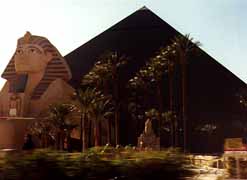
Pleasure Palace
|
We drove to Las Vegas across the Sierras and Death Valley. Leaving
the coast, we climbed the high green slopes of the coastal sierras
and crossed the very bottom of the California’s great central
valley where so much of America’s food (and - we found - cotton)
is raised. Irrigated fields stretched to the horizon. Bits of
cotton strew the countryside long after the harvest. In 1975 we
lived in Newfoundland, at the very farthest northeast point in
the western hemisphere, and remember the California trucks coming
in with fresh greens ($1.25 for a head of lettuce!!) from the
great valley.
As we moved further east we crossed the Sierra Nevadas, rocky
steep dry mountain slopes with sparse vegetation. My favorite
dry land plant is the Joshua Tree, a large yucca that looks like
a short telephone pole holding cheerleading pompoms. Early settlers
said it looked like a man in a pose of supplication, like Joshua
from the Bible. We drove mile after mile of sandy land, sometimes
strewn only with rocks in a parody of an agricultural field, sometimes
dotted with the bushes and shrubs and cacti of the desert. The
road went through long rises up from the desert floor around towering
rocky peaks and then would drop into another dry floor. It’s always
a surprise that a desert has hills and low valleys, and a variety
of vegetation.
Dry and hot. Death Valley is extremely hot, even in November.
I found myself using sunblock and a hat all the time. My eyes
hurt even with sunglasses. We had water with us always. There
were very few settlements, a store and restaurant at Stovepipe
Wells (where a stovepipe in the sand used to locate one of the
valley’s few wells for travelers) and a beautiful palm tree “plantation”
(too big and regular to be called a “grove”) at Death Valley Junction.
Death Valley is loaded with tourists who come out from Las Vegas.
We saw about a thousand Winnebagos parked at Death Valley Junction,
a meeting of the Forty-Niners Club. We saw the borax mines at
a distance. Miners and travelers have always come to Death Valley.
From Death Valley to Las Vegas the road is fairly easy. At Pahrump
we saw an odd town in the middle of fast planned growth. Small
housing developments were strewn across the dry valley on a grid
of streets with large empty areas. The residential streets of
the future ran right out into the desert and up the mountain slopes
to stop dead. Street signs and curbs and bus stops line the empty
spaces A “town center” was obvious, administrative buildings and
a line of shops along the highway. Real estate was obviously the
big business with signs everywhere. It seemed odd to see signs
lauding a new development planted on dusty open desert. Thousands
of dollars for an acre of sand and shrubs? Pahrump is a dot in
the desert sixty miles from Las Vegas. What draws people here?
For the next two days as we drove through Las Vegas and Kingman,
Az., and then the new towns along the Colorado (Bullhead City
and Laughlin, Ca.) we kept pondering how and why these desert
towns developed.
WHY DO CITIES DEVELOP WHERE THEY DO? Early cities were trading
crossroads, administrative sites, religious centers. People came
to sell surplus goods, buy products from other lands, pay taxes,
attend ceremonies. Cities were located where rivers met seas,
and inland products were transferred to ocean vessels, where goods
were bartered in huge markets, where the population worshipped
at mounds and plazas and temples. In the last few centuries the
industrial revolution has created new kinds of cities, factory
cities and mine cities where the huge workforce lives near its
workplaces. New England’s cities were located near the waterfalls
that fueled the textile mills - Lewiston and Waterville, Manchester
and Pawtucket. Detroit is a car-producing center, Pittsburgh is
steel, Danbury, Ct. hats, Chicago meat-packing. Denver was the
mining center of the Rockies. The railroads created cities where
products were on- and offloaded. Wars created cities as workers
moved in to take jobs in munitions production (San Diego and Seattle).
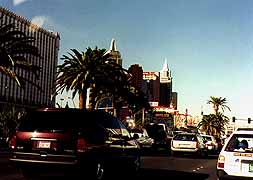
On the Strip
|
Once established, cities take on a life of their own and attract
people as population centers where businesses and cultural institutions
flourish. They go through growth cycles and times of maximum popularity.
Seattle and Portland are the boom cities of the far west, both
port cities. Portland is currently attracting thousands of footloose
young people as a music and counterculture center. Las Vegas and
the Colorado River towns are the boom areas of the desert. They
attract the elderly with lowcost housing and low maintenance and
warm climate.
|
Las Vegas at first sight is a desert mirage. At a distance the
towers and signs and stratosphere needle looks like gaudy playthings
in an empty land. The outer suburbs have houses dotting the desert,
then come the streets and industrial plants and finally the STRIP.
Wide boulevards lined by fantastic structures that are almost
all gaudy hotels and casinos: Caesar’s Palace, the Flamingo, the
Rio, the Luxor. Neon signs everywhere and gigantic TV screens
that advertise cheap meals and current shows. Huge fountains and
waterfalls gush (water sounds and cool mist in the desert !) Visitors
walk through triumphal arches or comic orifices the lion’s mouth
at MGM). Glass bridges reached by outdoor escalators span boulevards.
False volcanoes spew smoke and fire, pirate ships sail on canals,
ferris wheels turn on roofs. Slot machines are in every space
(services like pharmacies are few). The city is thronged. Today
Las Vegas is a tourist/convention mecca where we heard Dutch and
Arabic and French. I had heard Las Vegas has over 30,000 hotel
rooms.Our local friends thought that an underestimate, an annual
computer convention brings 128,000 people on its own.
The city is expanding. We heard the claim of 5000 in-migrants
a month. Housing is being thrown up on the edges of town. There
are derricks everywhere on the skyline with more casinos and hotels
underway. The hotel New York reproduces the whole Manhattan skyline
in bold colors. Five miles from the glitter and throngs the desert
is empty.
|
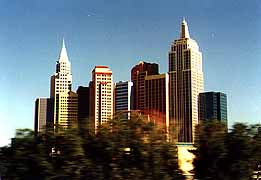
NY, NY from the highway
|
What brought people to Vegas in the first place? Location was
a key. Not the heat and dust and sand. It was over the line from
California in a state where gambling was allowed. AND there was
water, the Colorado River, nearby. In the 1930’s the Hoover Dam
was built providing reserves of electricity that would fuel the
multimillion light bulbs of the Strip. Developers gambled that
Americans would come to a recreation center focused on gambling.
They invested in casinos and hotels and entertainment venues.
They hired top entertainers (singers and comics and magicians
backed by showgirl troops). More recently, low plane fares and
holiday packages lure the throngs. A plane seemed to take off
every minute from the nearby airport. Las Vegas provides cheap
food and lodging and endless games of chance. If Americans are
the ultimate adventurers and risk-takers, Las Vegas is their mecca.






